Do Frogs Have Hair? The Answer Revealed

In this week’s Frequently Asked Question, I’ll be answering “Do Frogs Have Hair?”. It has a straightforward answer and it probably won’t surprise you. You may, however, be surprised to learn about 3 incredible frogs with hair-like strands!
A few species of frogs have hair-like structures on their bodies but, in each case, it’s technically not hair.
This topic is super interesting! I’m excited to cover it. If you have time to read everything, please do! Otherwise, I encourage you to skim the post and see the section about The Hairy Frog, Emei Mustache Toad, and the Thorny Tree Frog!
Table of Contents
A Few Reasons Frogs Don’t Have Hair
Frogs don’t have hair for multiple reasons. The main reason, one could say, is that they haven’t evolved hair. Or simply: they don’t need it. Frogs have specially adapted skin with protection from the elements.
Let’s take a look at the unique abilities of frogs while I explain the reasons they don’t have (or need) hair.
Frogs Breathe Through Their Skin
One of the neat things about frogs is their ability to breathe through their skin. Their skin is semi-permeable. It allows some substances to pass through, one of which is oxygen.
Yes, frogs can breathe through their skin. They absorb oxygen from their surroundings, mainly water. When frogs absorb oxygen from water it allows them to stay underwater for longer periods of time.
Having hair follicles would inhibit or greatly hinder the absorption of oxygen. This, of course, is problematic for animals that depend so much on the water for their survival.
Amphibians Don’t Need Hair to Thermoregulate
Thermoregulation is the process of maintaining internal body temperatures in spite of the surrounding temperature.
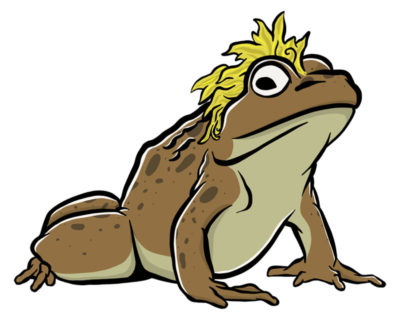
Hair serves an important function for mammals in terms of thermoregulation [1]. Hair protects animals from the elements; from the sun and harsh temperatures. For example, Fur, which is chemically indistinguishable from hair, adds a layer of insulation. Warm-blooded animals employ a number of strategies like sweating, shivering, and panting.
Frogs are ectothermic, cold-blooded animals. Cold-blooded animals don’t maintain a constant body temperature and they have a different process of thermoregulation.
Amphibians regulate their temperature by using their surroundings. They move to cooler locations in order to cool down. They can warm themselves by changing locations too. The sun provides warmth and some frogs can change their color in order to receive more solar radiation [2].
For this reason, frogs don’t need hair to regulate their body temperature.
Their Mucous Glands & Slimy Skin Protects Them
Another reason frogs don’t need hair, in terms of protection from some elements, is because the mucous on their skin provides protection.
What many people don’t know is that frogs have mucous glands that provide protection from microorganisms. Most amphibians spend their time in humid, damp environments, filled with harmful bacteria, algae, and fungi.
The mucous glands provide a slimy coat of protection from harmful microorganisms. Hence the reason frogs are slightly slimy and seemingly always wet.
On a side note: Frogs have toxins on their skin too, which acts as a defense mechanism from predators. Some toxins are more potent than others but frogs are generally harmless to humans with few exceptions.
So, where hair or fur would function as a barrier between some harmful substances and a furry mammal, frogs have a protective layer of mucous to negate harmful microorganisms.
3 Frogs With Hair-Like Structures
With over 7,400 species of Anura (frogs and toads) in the world, it’s safe to assume a few of them will sport fascinating attributes. This assumption is true and in the case of frogs with hair, or hair-like structures, we’ve got three!
Keep in mind, frogs don’t have hair but the species listed below appear to have hair-like qualities. Let’s take a look.
Hairy Frog
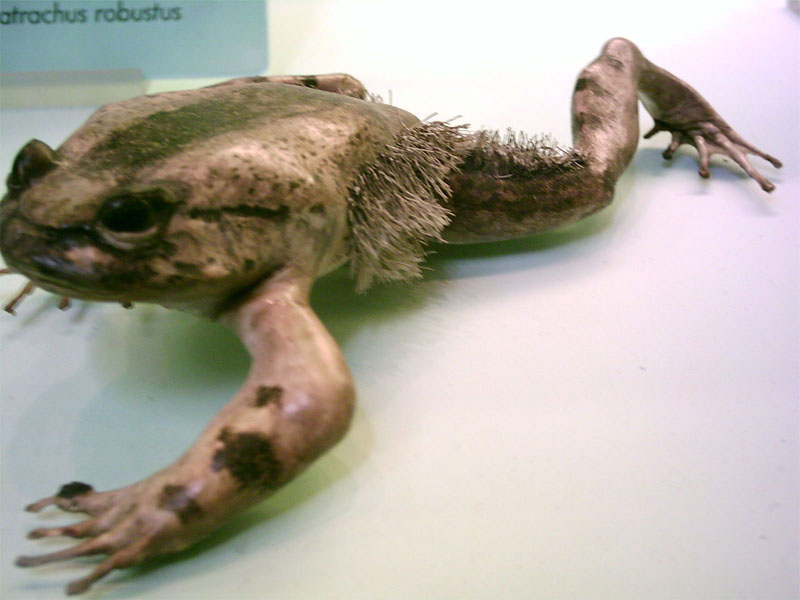
At first glance, you’d be convinced this frog has hair. After all, its common name is “hairy frog”. The hair-like appendages cover a portion of their sides and some of their legs. Oh, and it only occurs in the males of this species.
The hair-like strands are dermal papillae. They contain arteries and their purpose is most likely to increase surface area for the purpose of absorbing oxygen. A not-so-similar species in lake Titicaca has an excessive amount of skin that it uses to help absorb more oxygen from the water. This allows it to spend more time underwater.
Anyway, that’s enough about dermal papillae for now. I’ll talk more about it later. For now, let’s focus on the bizarre aspects of the Hairy Frog.
Hairy Frogs (Trichobatrachus robustus), also known as Horror Frogs or Wolverine Frogs, are found in Central Africa. They’re quite unique among amphibians, as you’ll soon learn. “Why?” You might ask. Well, all of its common names are eerily fitting.
It’s easy to see why one would call it “Hairy Frog”, but why is “Horror Frog” appropriate? And is it called “Wolverine Frog” because the hair-like strands slightly resemble Wolverine’s sideburns? Hah! Not quite… Let me tell you.
This species possesses retractable claws. Well, claw-like structures. They’re not made from keratin like real claws. So, that’s where the Wolverine part comes in. Here is where the Horror part comes in… Those “claws” are actually the frog’s bones[3]. Yeah, these little guys actually break their bones to intentionally use as a weapon. Scary, right?
Emei Mustache Toad
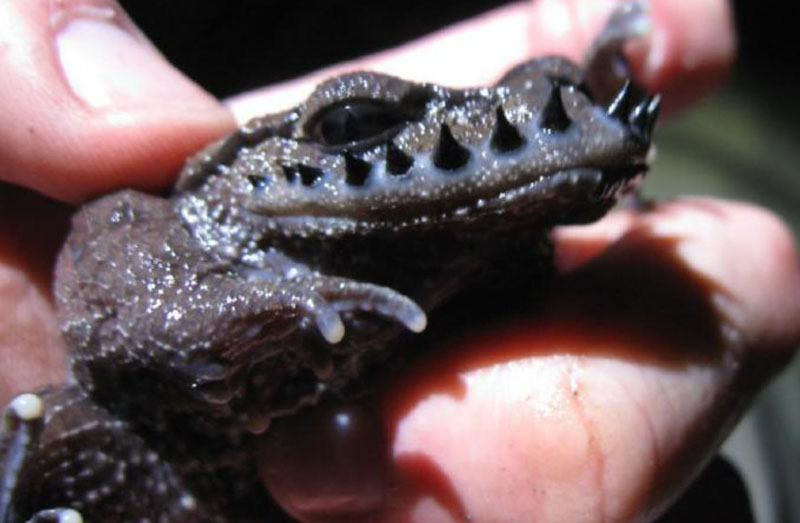
The Emai Mustache Toad (Leptobrachium boringii) is found in parts of China. As you can see in the pictures, it sort of has a “mustache” on its upper lip. I realize its mustache looks more like spikes but for the sake of this post, I had to include it.
The word “Emei” comes from Mount Emei which is located in the Sichuan province of China. The frog’s mustache-like spikes grow during the breeding season and they’re used for fighting for territories.
I found fantastic pictures but due to copyrights, I’m not able to post them here. You can view them on the Beauty of Science website (link opens in a new tab) if you’re interested. There you will find pictures and videos. Also, one picture of a tadpole looks like it has a little mustache already.
Thorny Tree Frog
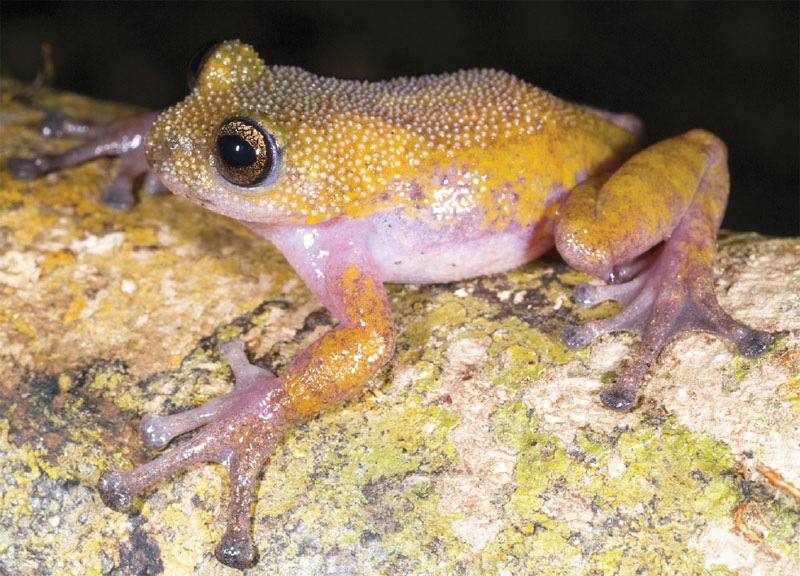
The Thorny Tree Frog is a newly discovered species found in the cool, high mountains of central Vietnam. The discovery came between 2009 and 2010 when biologists ventured to Mount Gnoc Linh and the surrounding peaks. A few new species were discovered, including this pokey little guy.
What we learned about the Thorny Tree Frog is that only males have the spines on their backs. Those spines, in my opinion, look similar to hair. The males of the species develop spines during the breeding season. They become more pronounced as the season continues.
Researchers believe the reason for the spines is to signal to females that the males are ready to mate.
Hair vs. Dermal Papillae vs. Cilia
This article wouldn’t be complete without explaining the difference between hair, dermal papillae, and cilia. After all, it’s the definition of each that defines whether or not frogs actually have hair.
Hair, of course, needs to be defined to establish a fair comparison. Trichome Dermal Papillae are the hair-like strands on the Hairy Frog. I’ve included cilia because it is a hair-like structure found on the surface of some cells.
- Hair – Made of protein filament called keratin that grows from follicles in the dermis. Dermis is the inner layer of skin.
- Trichome Dermal Papillae – An extension of the dermis (inner layer of skin) into the epidermis (outer layer of skin).
- Cilia – A microscopic hairlike structure found on the surface of certain types of cells.
In comparing the three, we’ve established that hair is made of keratin and grows from a follicle in the inner layer of skin. Trichome Dermal Papillae, in contrast, is an extension of the inner layer. In the case of the Hairy Frog, the appendages extend out from the body but it is not made of keratin. It’s a strand of skin.
By the way, trichomes are fine outgrowths or appendages. In layman’s terms, a trichome dermal papillae is an outgrowth of the inner layer of skin and it looks similar to hair. The diagram below should help!
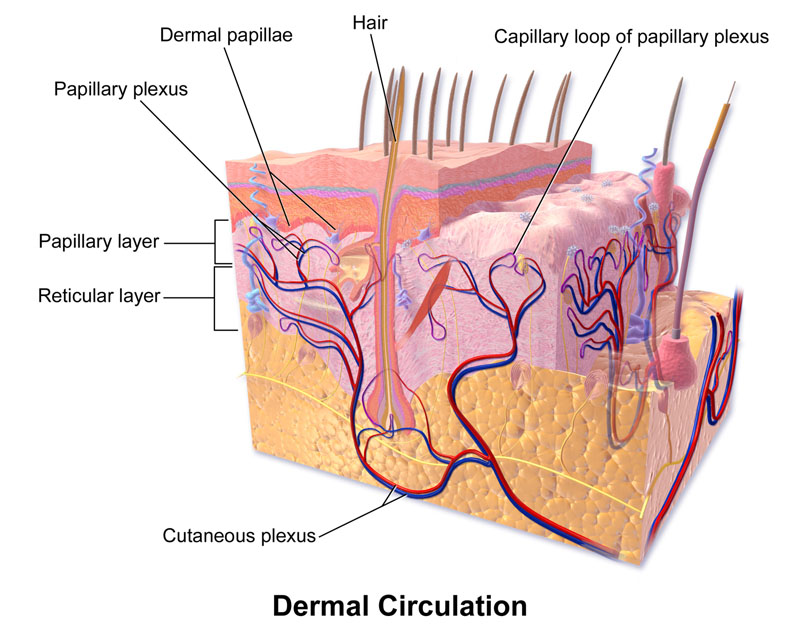
Finally, Cilia are worth mentioning because they’re a microscopic, hairlike structure found on cells. They serve different purposes. One such observation is that it helps propel mucus and debris caught in the roof of the mouth of frogs[4]. Again, you cannot see cilia with the naked eye and it is not hair.
TLDR; Do Frogs Have Hair?
Frogs do not have hair. Hair is a protein filament called keratin that grows from follicles in the inner layer of skin. The closest thing one species of frog has to hair is Trichome Dermal Papillae. It looks similar to hair but it is skin.
The frog that has Dermal Papillae outgrowths is unique among class Anura (frogs and toads). Its common name is “Hairy Frog” and you can see a picture of one in the featured photo at the top of the page. In short, male Hairy Frogs have Dermal Papillae appendages, which is an outgrowth of the skin. It results in a vascularized epidermis[5] which is thought to increase the surface area of skin for the sake of more easily absorbing oxygen through water. Still, it is not hair.
There are other species with hair-like structures on their bodies. The Emei Mustache Toad, for example, grows spikes on its upper lip during the breeding season. The “mustache” looks more like spikes than hair but it grows in the mustache region.
Another species worth mentioning is the Thorny Tree Frog, a newly discovered species from Vietnam. Males of the species have tiny spikes or thorns running atop their heads and backs. The thorns have a similar appearance to that of short hair. A buzz cut?
References
- Terrien, J. (2011). Behavioral thermoregulation in mammals: a review. Frontiers in Bioscience, 16(1), 1428. https://doi.org/10.2741/3797[↩]
- King, Richard B., et al. “Physiological Color Change in the Green Treefrog: Responses to Background Brightness and Temperature.” Copeia, vol. 1994, no. 2, 1994, p. 422. Crossref, doi:10.2307/1446990.[↩]
- Blackburn, David C., et al. “Concealed Weapons: Erectile Claws in African Frogs.” Biology Letters, vol. 4, no. 4, 2008, pp. 355–57. Crossref, doi:10.1098/rsbl.2008.0219.[↩]
- Aiello, Edward, and Michael Sleigh. “Ciliary Function of the Frog Oro-Pharyngeal Epithelium.” Cell and Tissue Research, vol. 178, no. 2, 1977. Crossref, doi:10.1007/bf00219053.[↩]
- Hofrichter, Robert. The Encyclopedia of Amphibians. Gardners Books, 2000., p. 83[↩]
